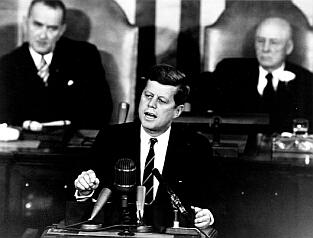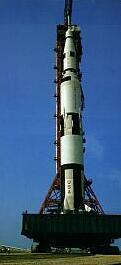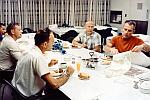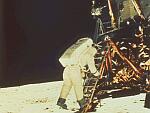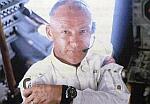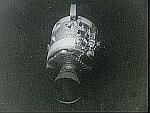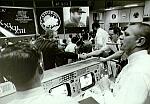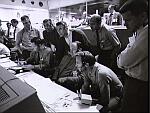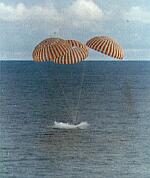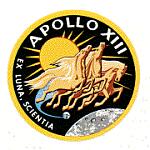
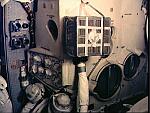
"The mailbox" - adapted carbon dioxide filter
|
Apollo 13 - 200,000 nautical miles from Earth
Monday April 13, 1970 - 10:06 pm Houston time (56 hours Mission Elapsed Time - MET)
After a few minor and easily-correctable mishaps at the beginning of the mission, Apollo 13 had settled down to what was looking like the smoothest flight of the program. So much so that at 46 hours 43 minutes MET, the CapCom (capsule communicator) on duty, Joe Kerwin, had radioed: "The spacecraft is in real good shape as far as we are concerned. We're bored to tears down here." That was soon to change.
Commander Jim Lovell was floating half-way between the command module (CM) and the lunar module (LM), wrestling with TV wires and a camera, when he heard "a rather large bang" and felt a vibration. This had happened before, when Fred Haise had to actuate a valve which normally gave the same sound, so Lovell didn't get concerned. He looked up at Fred in the LM as if to say, 'there you go again', then noted "Fred had that expression like it wasn't his fault. We suddenly realized that something else had occurred ... but exactly what we didn't know."
Up in the CM Jack Swigert, sitting in the left-hand or pilot's seat, had just carried out a routine instruction from Houston to stir the 'cryogenics' (liquid oxygen supplies) by activating the fans built into their respective tanks. A minute and a half later he heard the bang. Next thing he knew a master alarm was sounding and the main Bus 'B' undervolt (loss of electrical power) warning light came on. Then more warning lights came on, indicating the loss of two of Apollo 13's three fuel cells, the prime source of the craft's electricity. The needle of the pressure gauge for one oxygen tank was near zero, and that of the other one was going down. Without oxygen, the third fuel cell would also die. There was a backup battery-powered electric supply in the Command and Service Module (CSM) with a lifetime of up to 10 hours, but at that point, Apollo 13 was 87 hours from home. The three men in the craft and the team on the ground in Mission Control desperately tried to understand what had happened, and what the implications were.
Thirteen minutes after the explosion Lovell happened to look out of the left-hand window. "We are venting something out into the - into space," he reported. "It's a gas of some sort." It was oxygen escaping at a high rate from the second, and last oxygen tank. It was at about this point that Lovell's thinking went from "I wonder what this is going to do to the landing" to "I wonder if we can get back home again." He realised they were in serious trouble, and his life-long dream of walking on the moon was vanishing along with the trail of gas bubbles and debris outside the spacecraft.
What in fact had happened was set in train two years previously, and should have been completely preventable. The no. 2 oxygen tank used in Apollo 13 had originally been installed in Apollo 10. It was removed from Apollo 10 for modification and during the extraction was dropped 2", slightly jarring and probably damaging an internal fill line. The internal fill line was not known to be damaged, and the tank was subsequently installed in Apollo 13.
The oxygen tanks were originally designed to run off the 28 volt DC power of the command and service modules, but were later redesigned to also run off the 65 volt DC ground power at Kennedy Space Center. All components were upgraded to accept 65 volts except the heater thermostatic switches, which were overlooked. During pre-flight testing the tank would not empty correctly, and it was decided to "boil off" the excess oxygen. This required 8 hours of heating using the 65 volt power, with the probable result that damage occurred to the thermostatically controlled switches on the heater, which were designed for only 28 volts. The switches may have welded shut, allowing the temperature within the tank to rise to over 1000°F, damaging the teflon insulation on the electrical wires to the power fans within the tank. When Swigert turned on the fans to stir the oxygen the exposed wires shorted and the teflon insulation caught fire. This fire spread along the wires to the electrical conduit in the side of the tank, which weakened and ruptured, causing the no. 2 oxygen tank to explode. This in turn damaged the no. 1 tank and parts of the interior of the service module and blew off bay no. 4 cover, exposing the internals to the hazards of space.
Lovell and his crew were now faced with the following problems:
- a dead Service Module, including its main propulsion engine
- little battery power, meaning consumption had to be drastically reduced
- insufficient water
- an incorrect course to allow a 'free return' to Earth
- an unknown amount of damage to the SM, with possible damage to the heat shield on the CM
- a potentially deadly build-up of carbon dioxide.
Paradoxically, oxygen for breathing was not a problem, as there were alternative sources of supply in the Lunar Module.
To conserve water the crew cut down to six ounces per day, a fifth of the normal intake, and used fruit juices. They became dehydrated and lost a total of 31.5 lbs, nearly 50% more than any other crew. Lovell alone lost 14 lbs.
The reduced battery power, and the need to have enough voltage remaining to power the Command Module for re-entry, was the major hurdle. Every non-essential electrical item was shut down, including the CM computer. Without the internal systems operating, the temperature in the CM dropped to 38°F and condensation dripped from the walls. The crew retreated to the Lunar Module where it was slightly warmer (although still very cold) but this caused another problem: the LM was designed to support 2 men for 2 days, not 3 men for nearly 4 days. Before long the carbon dioxide overload warning light came on. There were plenty of lithium hydroxide canisters (which remove carbon dioxide exhaled by the crew) on board, but the square canisters from the CM were not compatible with the round openings in the LM. Eventually Houston managed to come up with instructions on how to make an adapter using plastic bags, cardboard and duct tape—all materials carried on board. The carbon dioxide levels soon dropped to normal.
The next problem to overcome was how to get Apollo 13 back on to a course which would allow it orbit the moon and then head back to Earth. Normally this course correction would be achieved by means of a timed "burn" of the SPS (service propulsion system) engine; this time they had to use the LM's descent engine, which was designed for a different purpose altogether. Houston ran the numbers through the computers and simulators on the ground, instructed the crew and waited; the engine fired, the manoeuvre was successfully executed, and everyone breathed a sigh of relief. Another burn lasting 263.4 seconds took place two hours after rounding the far side of the Moon. A third burn of 15 seconds at 10% throttle was carried out to get the spacecraft more towards the centre of the re-entry corridor. But it was the fourth and final burn, to correct the re-entry angle, that was possibly the most critical.
When a spacecraft returns to Earth, travelling at a speed of 25,000 mph, its angle of re-entry is paramount; the zone of safety is a cone 2° wide, from 5.5° to 7.5°. Too shallow an angle and the spacecraft will bounce off the atmosphere and continue out into infinity; too steep an angle and it will burn up like a breadcrumb caught in a toaster. By way of illustration, if the Earth were the same size as a basketball, getting the correct angle is like trying to hit the edge of a thin sheet of cardboard balanced on top of it. The three cold and fatigued astronauts knew their lives depended on getting the angle just right, and they had to do it manually without the normal battery-powered navigational and timing aids. Houston calculated the length of the burn to be 22.4 seconds—not a second more, not a second less. During the burn Fred Haise looked after the pitch angle of the ungainly craft (SM plus LM plus CM all joined together); Jim Lovell controlled the roll angle and pushed the buttons to start and stop the engine; and Jack Swigert used his Omega Speedmaster to call out the start and stop times. If ever there was a time to have faith in the reliability of one's watch, this was it. The three of them did such a good job that the re-entry angle ended up at 6.49°—smack in the middle of the 'zone of safety'.
|
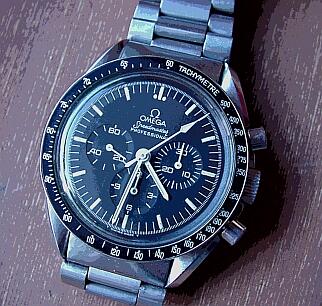
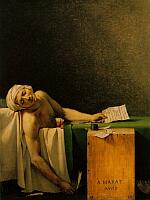
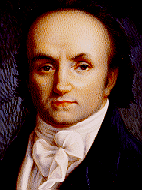 In April 1793, while the two men were visiting a mutual acquaintance in Paris, a royalist crowd gathered outside demanding Marat's head. He was trapped. To save his friend, Breguet dressed him up as a woman, complete with powdered face and reddened cheeks. They waited until evening and then calmly walked out arm in arm, mingling with the crowd until Marat could flee to safety. The revolutionary had the opportunity to return the favor two months later. Hearing that Breguet, because of his royalist connections, had been placed on a death list by the Revolutionary Committee, Marat urged him to leave France. He arranged for safe-conduct passes for Breguet and his son, who had returned from England, to get across the Swiss border. It was the last time that the watchmaker would see his friend. The Terror had begun.
In April 1793, while the two men were visiting a mutual acquaintance in Paris, a royalist crowd gathered outside demanding Marat's head. He was trapped. To save his friend, Breguet dressed him up as a woman, complete with powdered face and reddened cheeks. They waited until evening and then calmly walked out arm in arm, mingling with the crowd until Marat could flee to safety. The revolutionary had the opportunity to return the favor two months later. Hearing that Breguet, because of his royalist connections, had been placed on a death list by the Revolutionary Committee, Marat urged him to leave France. He arranged for safe-conduct passes for Breguet and his son, who had returned from England, to get across the Swiss border. It was the last time that the watchmaker would see his friend. The Terror had begun.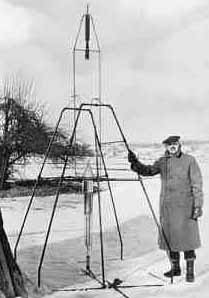 It didn't look much like a rocket as we know it today—more like a piece of modern sculpture supported by the frame of a child's swing. Curiously, the engine part where the gases emerged was placed not at the rear of the rocket, but at the front of it; below were suspended the tanks holding the liquid propellents and the fuel pumps. A small conical shield protected the tanks from the heat of the exhaust.
It didn't look much like a rocket as we know it today—more like a piece of modern sculpture supported by the frame of a child's swing. Curiously, the engine part where the gases emerged was placed not at the rear of the rocket, but at the front of it; below were suspended the tanks holding the liquid propellents and the fuel pumps. A small conical shield protected the tanks from the heat of the exhaust.